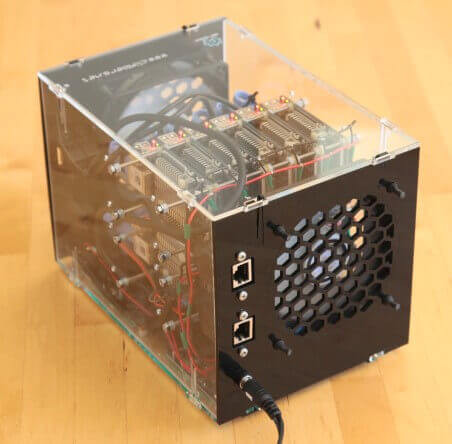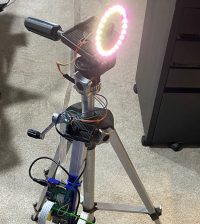- How to Adjust X and Y Axis Scale in Arduino Serial Plotter (No Extra Software Needed)Posted 7 months ago
- Elettronici Entusiasti: Inspiring Makers at Maker Faire Rome 2024Posted 7 months ago
- makeITcircular 2024 content launched – Part of Maker Faire Rome 2024Posted 9 months ago
- Application For Maker Faire Rome 2024: Deadline June 20thPosted 10 months ago
- Building a 3D Digital Clock with ArduinoPosted 1 year ago
- Creating a controller for Minecraft with realistic body movements using ArduinoPosted 1 year ago
- Snowflake with ArduinoPosted 1 year ago
- Holographic Christmas TreePosted 1 year ago
- Segstick: Build Your Own Self-Balancing Vehicle in Just 2 Days with ArduinoPosted 1 year ago
- ZSWatch: An Open-Source Smartwatch Project Based on the Zephyr Operating SystemPosted 1 year ago
The Monster: 12 octa-core NanoPi-Fire3 SBCs for a 96-core cluster computer!

Research centers and universities around the world have developed RPi-based cluster computing for research into parallel computing, deep learning, medical research, weather simulations and more. With this in mind, Paul Smith’s project is an impressive cluster computer with open source design: it combines 12 octa-core NanoPi-Fire3 SBCs for a 96-core cluster.
The open source cluster design includes Inkscape code for laser cutter construction. Smith made numerous changes to his earlier clusters intended to increase heat dissipation, improve durability, and reduce space, cost, and power consumption. These include offering two 7W case fans instead of one and moving to a GbE switch. The Bill of Materials ran to just over £543 ($717), with the NanoPi Fire3 boards totaling £383, including shipping. The next biggest shopping item was £62 for microSD cards.
The 75x40mm Fire3 SBC houses a powerful Samsung S5P6818. The SoC features 8x Cortex-A53 cores at up to 1.4GHz and a Mali-400 MP4 GPU, which runs a bit faster than the Raspberry Pi’s VideoCore IV.
Performance would no doubt improve if Smith had used the new Raspberry Pi 3 Model B+, which offers a Gigabit Ethernet port. However, since the B+ port is based on USB 2.0, its Ethernet throughput is only three times faster than the Model B’s 10/100 port instead of about 10 times faster for the Fire3.
Below a short comparative table of NanoPi-Fire3 vs Raspberry Pi 3 Model B:
| Model | NanoPi-Fire3 | Raspberry Pi 3 model B |
|---|---|---|
| SoC | 8-core ARM A53 S5P6818 @ 1.4GHz |
4-core ARM A53 BCM2837 @ 1.2GHz |
| Memory | 1GB DDR3 | 1GB DDR2 |
| GPU | Mali-400 MP4 500MHz? |
Broadcom VideoCore IV 400MHz? |
| Network | 1000Mbps | 100Mbps |
| WiFi | no | 802.11bgn |
| Bluetooth | no | 4.1 + BLE |
| Storage | microSD card | microSD card |
| USB spare | 1 fitted 1 microUSB |
4 fitted |
| Video | Micro HDMI 1.4a, RGB-LCD | HDMI, DSI |
| Camera ports | DVP | CSI |
| Audio | no | 3.5mm |
| Size | 75 x 40mm | 85 x 56mm |
| Power | 1.2 → 3.6W 2A max, microUSB |
1.2 → 2.1W 2.5A max, microUSB |
| Launched | Q4 2017 | Q1 2016 |
| Price (UK) | £34.301 | £33.59 |
All you need to know about this project is available at Climbers.net!
















